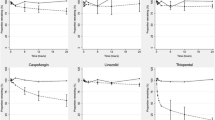Summary
Immediately following the connection of pediatric patients to cardiopulmonary bypass we have consistently observed a steep decrease in fentanyl plasma concentration (74±8.7%) (mean±SD), much greater than would have been expected from hemodilution alone (50.6%±12.0%) (p<0.0001). Priming of the pump with 20 ng/ml of fentanyl before connection to the patients did not prevent this phenomenon. In order to study the possibility that fentanyl is sequestered by the bypass, levels of the primed drug in the bypass were assessed before connecting the pump to the children and a steep fall from 20 ng/ml to zero was shown before initiation of bypass. Pharmacokinetic assessment of fentanyl in a closed pump circuit showed that levels of 120 ng/ml fall to 2 ng/ml within 3 min and remain stable at the lower concentration for at least 30 min. Further studies have identified the membrane oxygenator as the major site of fentanyl sequestration. Concentrations across the membrane fall from 120 ng/ml to 10 ng/ml. The attached siliconized tubing is associated with a minor binding effect sufficient to reduce concentrations from 110 to 84 ng/ml. The pvc tubing, aluminium heat exchanger and plastic reservoir had no binding effect on fentanyl. The possibility that a decrease in fentanyl protein binding caused the fall in serum concentration was checked in 5 patients undergoing open heart surgery. After initiation of the cardiopulmonary bypass, there was a significant decrease in albumin serum concentrations from 32.0±2.3 mM to 15.0±1.6 mM (p<0.0001). Since this decrease is identical to the dilutional effect anticipated on initiation of bypass, it is unlikely that there was any change in free fentanyl concentration from that observed in the prebypass period.
Similar content being viewed by others
References
Soudijn W (1978) The pharmacology and the pharmocokinetics of fentanyl. In: Wood C (ed). Stress free anaesthesia. International congress and symposium series. No.3 The Royal Society of Medicine, pp 3–10
Sprigge JS, Wynands JE, Whalley DG, Bevan DR, Townsend GE, Nathan E, Patel YC, Srikant CB (1982) Fentanyl infusion anesthesia for aortocoronary bypass surgery: plasma levels and hemodynamics. Anesth Analg 61: 972–978
Baskoff JD, Stevenson RL (1981) Fentanyl pharmacokinetics in children with heart disease. Anasthesiology 55: A194
Bently JB, Conahan TJ III, Cork RC (1982) Lung sequestration of fentanyl during cardiopulmonary bypass. Anesthesiology 57: A244
Bently JB, Borel JD, Nenod RE, Gillespie TJ (1982) Age and fentanyl pharmacokinetics. Antsth Analg 61: 968–971
McClain DA, Hug CC Jr (1980) Intravenous fentanyl kinetics. Clin Pharmacol Ther 28: 106–114
Crean P, Goresky G, Koren G, Klein J, MacLeod SM, Roy L (1983) Fentanyl pharmacokinetics in children with congenital heart disease. Anesthesiology 59: A448
Bovill JG, Sebel PS (1980) Pharmacokinetics of high-dose fentanyl. Br J Anaesth 52: 795–801
Koska AJ, Romagnoli A, Kramer WG (1981) Effect of cardiopulmonary bypass on fentanyl distribution and elimination. Clin Pharmacol Ther 29: 100–105
Bentley JB, Conahan III TJ, Cork RC (1983) Fentanyl sequestration in lungs during cardiopulmonary bypass. Clin Pharmacol Ther 34: 703–706
Coltar DJ, Chamberlain DA, Howard MR, Kettlewell MG, Smith TW (1971) Effect of cardiopulmonary bypass on plasma digoxin concentrations. Br Heart J 33: 334–338
Krasula RW, Hastreiter AR, Levitsky S, Yanagi R, Soyka LF (1974) Serum, atrial and urinary digoxin levels during cardiopulmonary bypass in children. Circulation 49: 1047–1052
Gillespie TJ, Gandolfi AJ, Maiorino RM, Vaughan RW (1981) Gas chromatographic determination of fentanyl and its analogues in human plasma: J Analyt Toxicol 5: 133–137
Rudolph AN Pediatrics, 16th edition, Appleton-Century-Crofts, New York, p 1112
Hug CC Jr, Murphy MR (1981) Tissue redistribution of fentanyl and termination of its effects in rats. Anesthesiology 55: 369–375
Stanski DR, Hug CC Jr (1982) Alfentanyl — a kinetically predictable narcotic analgesic. Anesthesiology 57: 435–438
Dasta JF, Jacobi J, Shu Wir L, Sokolski T, Beckley P, Reilley TE, Howie BM (1983) Loss of nitroglycerin to cardiopulmonary bypass apparatus. Crit Care Med 11: 50–52
Holley FO, Ponganis KV, Stanski DR (1982) Effects of cardiopulmonary bypass on the pharmacokinetics of drugs. Clin Pharmacokinet 7: 234–251
Yuen DH, Denman SL, Sokolski (1973) Loss of nitroglycerin from aqueous solution into plastic intravenous delivery systems. J Pharmac Sci 68: 1193–1195
Zola EM, Lloyd J, Enever R (1981) Availability of thiopental from IV containers. American Society of Hospital Pharmacists New Orleans (abstract)
Author information
Authors and Affiliations
Rights and permissions
About this article
Cite this article
Koren, G., Crean, P., Klein, J. et al. Sequestration of fentanyl by the cardiopulmonary bypass (CPBP). Eur J Clin Pharmacol 27, 51–56 (1984). https://doi.org/10.1007/BF02395206
Received:
Accepted:
Issue Date:
DOI: https://doi.org/10.1007/BF02395206




